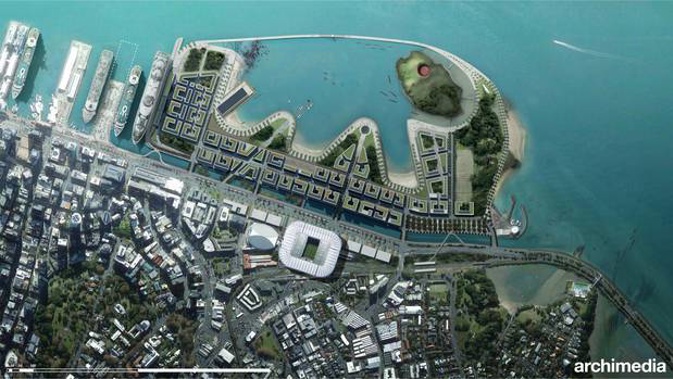
Four new inner-city beaches, a 40m-wide canal, parklands and a lagoon with a boardwalk around its edge all feature in a new plan for Auckland's container port.
It's not an official plan. But it is the first really big attempt by anyone to think through how the land could be used if it wasn't full of used cars and containers.
The plan also includes 4000 apartments, offices and a hospitality strip, an underground Maori historical and cultural centre with its own "volcano" and even a new stadium.
Land would be leased, not sold, and 65 per cent of the area would be retained for public use.
The plan was created by Archimedia, an Auckland architectural firm that worked on the Auckland Art Gallery and the University of Auckland's Business School, and designed Te Oro community centre in Glen Innes. It will be presented to the Auckland Council today.
In an exclusive interview with the Herald, Archimedia principal Lindsay Mackie said they know the whole thing "could take decades to build" but they're keen to kickstart the planning with some big creative thinking.
"The debate gets stuck on what happens to the cars, or what happens to the containers," he said. "We want people to talk about great ways to use that land."
/arc-anglerfish-syd-prod-nzme.s3.amazonaws.com/public/NS67PSA7S5GWFEFX4OXM2CPVDM.jpg)
Mayor Phil Goff has repeatedly said he wants to relocate the port and free up the land for public use. Mackie said their aim was to show Aucklanders what that could mean.
Goff has welcomed the plan can be self-funded, he'd love to see it become a reality.
"I think it's a great design, it's really stimulating, and I think that we can ultimately do something really exciting for our waterfront."
Infrastructure Minister Shane Jones has seen the plan. He told the Herald, "It is incredibly uplifting to see such a visionary creative project coming out of Auckland, and not imposed from Wellington."
But, he added, "These things, biologically speaking, have a deep and long gestation. But it certainly resonates with me."
The proposal ticks a lot of green boxes. "Walkability is the key," Mackie said. Vehicles would be able to use only some of the access roads and parking would mainly be underground. There are water turbines and solar energy units to make the whole thing self-sufficient in energy.
But it would be expensive. Alan McMahon, national director of commercial real-estate specialists Colliers International, told the Herald the cost of preparing the land for development is about $1.2 billion. That includes an estimate of $450 million in land value, which many will see as conservative.
Mackie said the proposal was developed with artist and urban designer Bernard Makoare, who was also involved with Archimedia on the Auckland Art Gallery and Te Oro. Makoare is from Ngati Whatua Orakei, but his engagement with the company is in a personal capacity.
The plan has several striking features. One is an island in the northeast corner of the site. It's a hill with a "volcanic" motu or cone, that would in reality be the grassed roof of a cultural history centre dedicated to Ngati Whatua and the history of Maori settlement on the isthmus.
The volcano isn't designed to explode, but it would be filled with photo-voltaic cells that glow red in the evening. The waterway around the island is a tidal estuary.
A 40m-wide canal or channel runs parallel to Quay St, creating a water's-edge quality all the way along the street.
The lagoon has three new beaches and is completely surrounded by a 20-metre boardwalk. It's for swimming, waka ama, paddle boarding and other water pursuits. Another new beach is sited on the east flank near the emergency services hub at Mechanics Bay, which would remain.
The concrete Toyota building currently on the port site would be restored as a base for water recreation, a market and artists' studios. The building has no heritage classification and is at risk of demolition by Ports of Auckland.
/arc-anglerfish-syd-prod-nzme.s3.amazonaws.com/public/E54HGFO3W5EGDGOBVHGMHDTFPI.jpg) An aerial view of Waitemata Harbour showing the Auckland port area and redevelopment as proposed by Archimedia. (Picture / Supplied)
An aerial view of Waitemata Harbour showing the Auckland port area and redevelopment as proposed by Archimedia. (Picture / Supplied)
Cruise ships would berth on the outer west side of the area, which is big enough to take the giant Oasis-class boats – the largest cruise ships in the world. The second and third berths would remain at Queens Wharf and Princes Wharf.
The buildings on site would be medium-rise only: four to seven storeys. Basements might be used for car parking or storage, the ground floor would be retail with offices above, with apartments on the upper floors.
A 10m-wide hospitality strip for cafes, bars and restaurants would be developed between the seaward buildings and the boardwalk. The entire built area would be at least two metres above sea level, to minimise the risks from climate change.
The stadium shown in the plans is the Allianz Stadium in Turin. It has a rectangular shape and steeply pitched seating that puts the entire 45,000-strong crowd close to the action. Archimedia propose their stadium would also have a retractable roof.
Mackie says the stadium is not essential to the proposal, although he hopes it happens. That's one reason it's sited next to the Spark Arena, not on the port land. To do this, Quay St would be straightened and a land swap would be required with Ngati Whatua, which owns the land all round the Arena.
The council will discuss Archimedia's plan today and probably refer it to officials. Those same officials will be reporting later in the meeting on Ports of Auckland Ltd's own 30-year plan for the site. They also have the council's City Centre and Waterfront Master Plan, which is in draft form, to consider.
The Archimedia plan dovetails pretty well with the council's draft plan, but it doesn't fit with POAL's plan. POAL foresees itself, over the next 30 years, holding onto the site for its existing operations, doing some wharf realignment and reclamation, and adding buildings.
If the Archimedia plan is to have any chance of success, the council will have to put a stop to POAL's ambitions for that land.
Council planning committee chair Chris Darby told the Herald he liked the Archimedia proposal and was "excited about the conversation". He also warned that "interim decisions" should not be taken that would stop bigger and better ideas from happening later on. That was a dig at POAL.
That's not the only issue. Ngati Whatua wants to buy the Ports of Auckland land.
"We have made this known over many generations," iwi spokesperson Ngarimu Blair told the Herald last year. "If the opportunity arises we would like to buy it. We are the natural owner."
Blair was consulted by Archimedia on this new project, and he told the Herald yesterday he liked what he had seen. "It's ambitious, we need that. And generally it's what is required. It puts Aucklanders back in touch with the water's edge."
Blair said the plan didn't undermine Ngati Whatua's desire to own the land. "We're open to anyone who wants to talk to us about good ideas."
Goff has consistently said the port land is not for sale.
Then there is the question of cost. Using Colliers' estimates, it's likely the development could pay for itself. And, say Mackie and McMahon, it could provide the council with about half a billion in revenue, plus maybe $40 million in rates per year.
That sounds like good news. But the cost of shifting the port will be upwards of $5 billion. If port land is to help fund its relocation, some of the new buildings on it may need to be very much taller.
There's no easy way through these issues, although there is a process that might help.
Shane Jones said the port study group, promised in the Government's coalition agreement, would be established soon. He hoped Archimedia and others with good ideas would make themselves known to it.
In the meantime, following Archimedia's lead, it's the council's turn to be bold. To open up the debate, to embrace the long-term potential and not get lost in the short-term problems.
Take your Radio, Podcasts and Music with you









